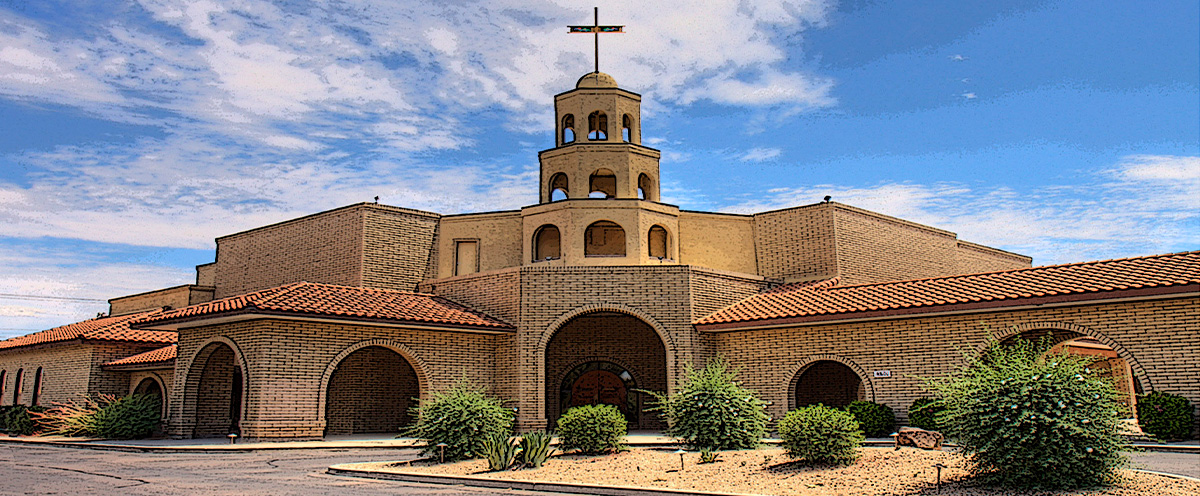Our Wall Mural
All the visual elements of the mural have a traditional Christian use and meaning. It is of interest to note that all of these elements have also been used in the traditional arts of the Southwest Americans dating back to prehistory. The overall theme of the mural is the story of Christ the Redeemer. It is the centerpiece of a three-part celebration of the Holy Trinity. The other two parts are the featured windows which border the mural.
The left design is the large four-pointed star shape, often referred to as the Bethlehem Star. It is a reference to the birth of Christ. This specific star shape is found on Anasazi weaving borders.
In the center of the star is a Squared Spiral. Christianity and other faiths have used this symbol as a sign of eternal life. Jesus came from all eternity. The eternal God became incarnate at Bethlehem. It is also used in the earliest times in baskets and later in painted pottery.
The Latin cross image is the commonly used Christian symbol. It is tilted to give perception of being carried. It specifically refers to Christ carrying the cross on the way to the hill of Calvary. It is the highest element in the mural which portrays the sense of victory. The cross in many forms has been used in southwest Native American art. The Latin cross can be found on Apache headwear and on Mimbra tribe pottery.
The large Butterfly on the right is a reference to Christ’s resurrection. This is the most complex image of the three chief symbols in the mural. The butterfly was used frequently on the Hopi bowls from the Sikyatki village.
Below the butterfly is an Hourglass shape. The water hourglass was employed by the Hohokam tribe to identify themselves as “children of the water.” Similarly, as we become “children of the water” in baptism, we receive the benefits from, and participation in, the death and resurrection of Christ. This is a visual image of Romans 6: Another image appears between the bottom of the Latin cross and the hourglass. This is the
Phoenix Bird, another Christian symbol of Christ’s resurrection and ours. It is also a specific reference to our city and its resurrection from the ashes of history.
As one contemplates on the mural, each may discover other hidden symbols which can further enrich the mural’s meaning. For example, the story of one’s own salvation rooted in the soil of the earth, and the cross opening us to the windows of heaven.
Relief Surface Building
The technique of executing the mural is:
Concrete is layered over a built-up sub-surface. Over the concrete is applied many layers of acrylic copolymer pigments. The application of materials and pigments is intended to reflect the colors and textures of the Arizona landscape, as well as the earthy and warm subtleties of its traditional arts, peoples, and vistas. It is more than a historic reference to the life of Christ using traditional recognizable images. If is an affirmation that Christ the Redeemer is affirmed as being with us, here and now.
The Creation Window
(Left of Mural)
The Creation Window is a call to trust God as the Lord and Giver of life. The window displays the Creator image (circle), with the creation elements of the sun, moon, and rain. The Rainbow image represents God’s promise to bless the earth with new life.
The Christian Life Window
(Right of Mural)
The Christian Life Window is a call to trust God as our strong companion as the church journeys through life’s adversities toward home in paradise. The path is rocky and filled with thorns, but never without signs of hope, symbolized by the desert blooms. The Christian sojourner is supplied with hope, faith, direction, and strength on the journey of life. The top circle in the window, as in the creation window, is a symbol for the Creator who lifts up the hurting earth to bless it with His healing and restoration which comes through His church and the means of grace, the Word and Sacraments.
The Altar, Pulpit, Processional Cross & Front Door
The Pulpit symbolizes God’s proclamation of The Good News to weary travelers and a world pulsating under sin’s consequences.
The Altar symbolizes Christ’s sacrifice of His lifeblood for our sins, without which we would have no hope or salvation. The different colored weaving bands around the altar are of Navaho design, symbolizing the seasons of the church year and the five Wounds of Christ.
The Processional Cross illustrates the victory of Christ over the enemies of sin and death on the brightly colored side, and the passion of Christ on the opposite dark side, reminding us of the high price of our redemption.
The design of the Front Door leading into the narthex and sanctuary is a replicate of the processional cross.
The Artist
The artist and designer of the mural, windows, altar, pulpit, processional cross, front door and candlesticks is Richard R. Caemmerer, Jr. (1933-2016). He was Founder and Director of the Grunewald Guild of Plain, Washington. Prior to that time, he was Professor of Art at Valparaiso University, IN from 1958-1981. He created stained glass, sculpture, fresco, graffito, and tapestry for about 600 churches throughout the United States, Canada, Europe, Africa, Central America, and Yugoslavia, representing all denominations. His paintings hang in museums and private collections around the world.
Special Thanks to Tip Tipton. Tip built the alter, pulpit and baptism.


 Launch the media gallery 1 player
Launch the media gallery 1 player